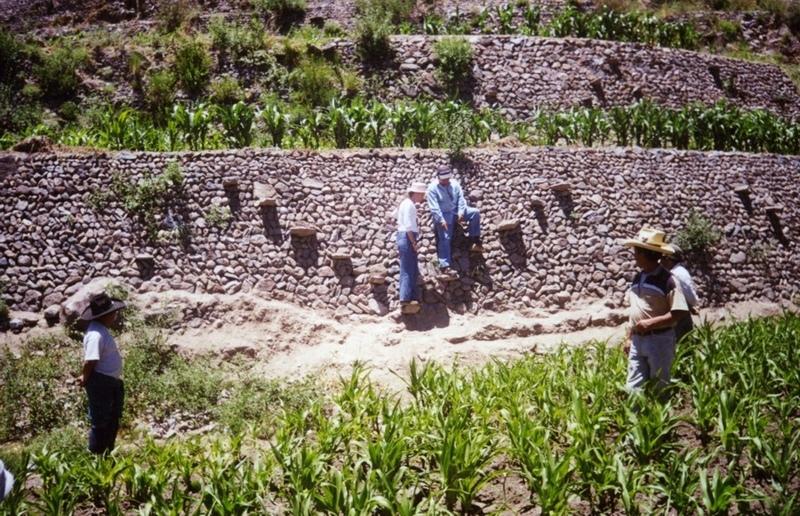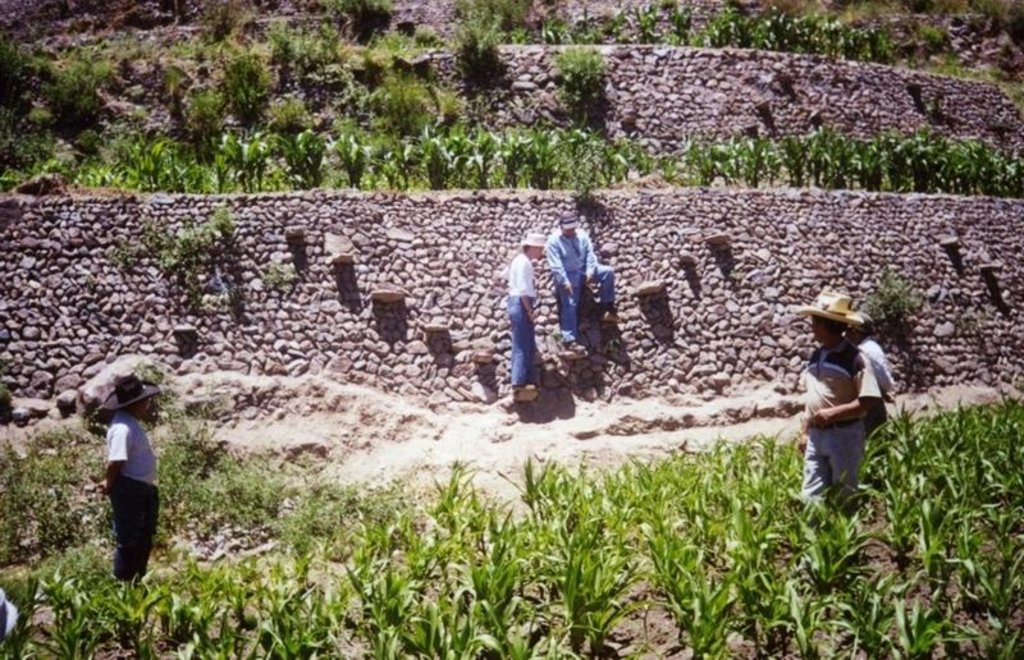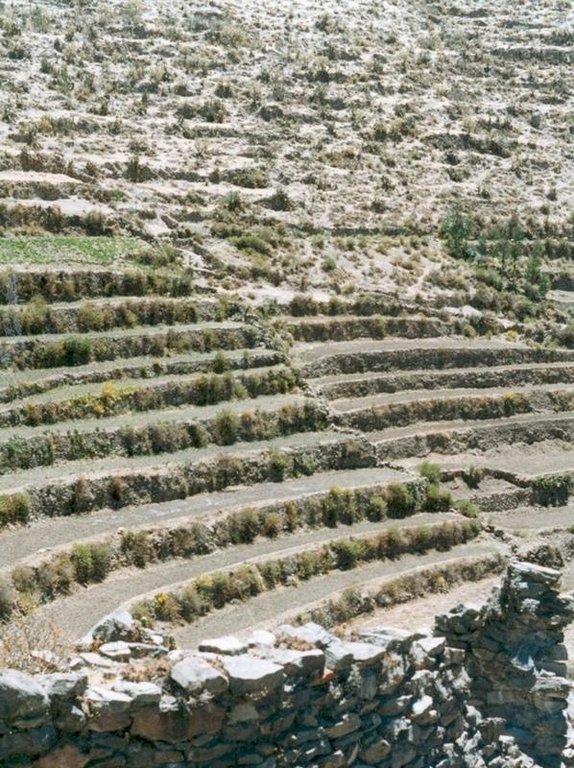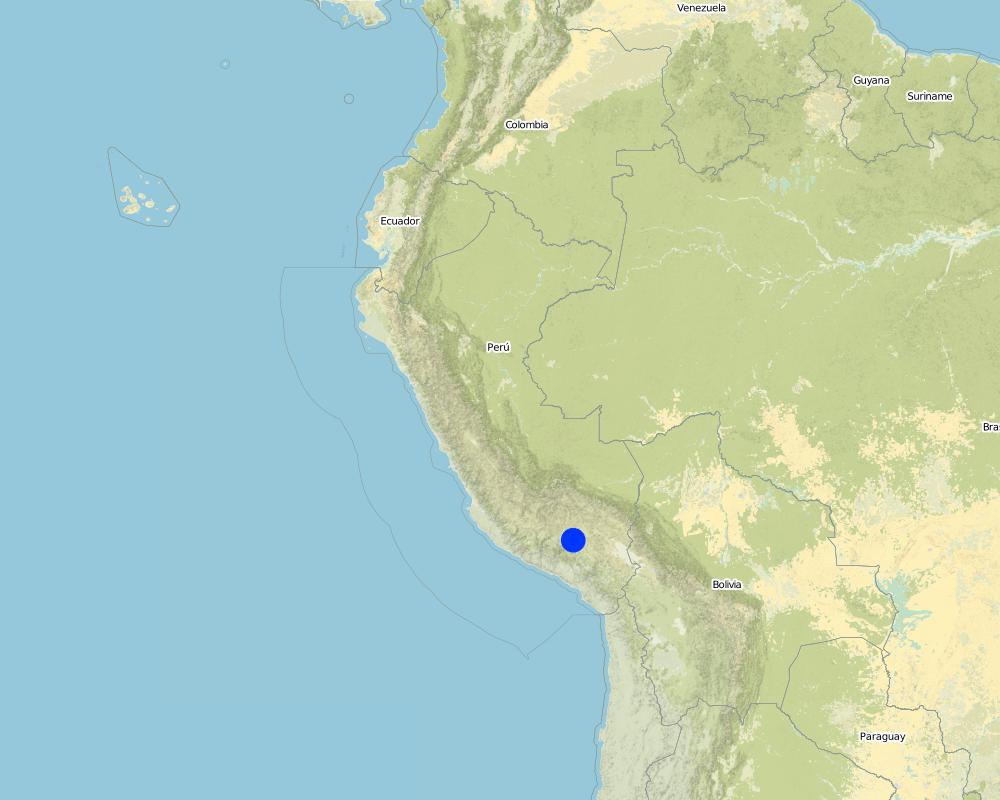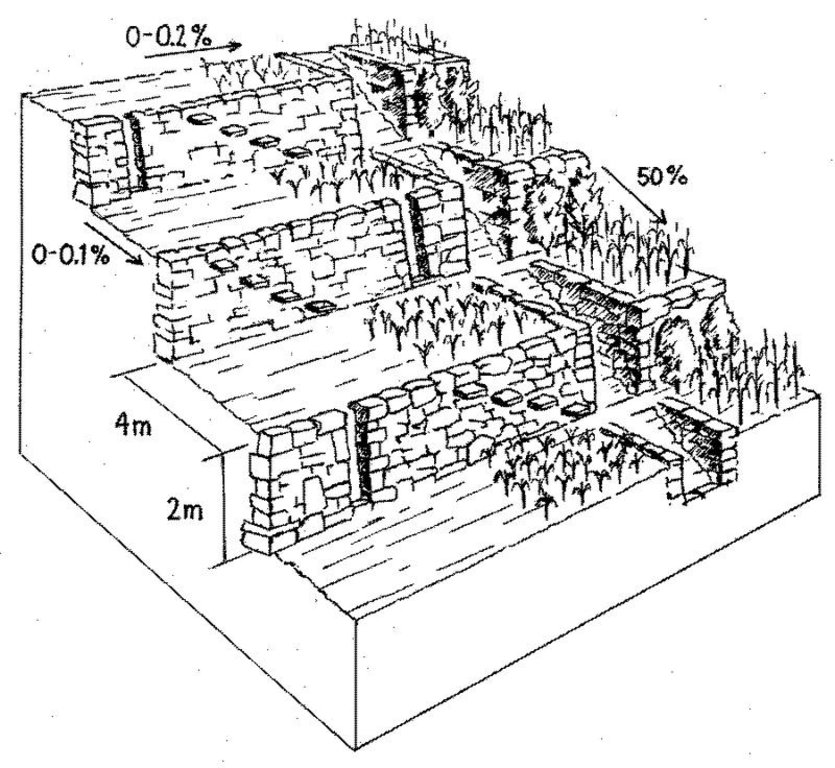Rehabilitation of ancient terraces [بيرو]
- تاريخ الإنشاء:
- تحديث:
- جامع المعلومات: Unknown User
- المحرر: –
- المراجعون: Fabian Ottiger, Alexandra Gavilano
Andenes / Anchacas / Patapatas
technologies_1506 - بيرو
عرض الأقسام
توسيع الكل طي الكل1. معلومات عامة
1.2 تفاصيل الاتصال بالأشخاص الرئيسيين لمصدر المعلومات والمؤسسات المشاركة في تقييم وتوثيق التقنية
الشخص (الأشخاص) الرئيسي لمصدر المعلومات
متخصص في الإدارة المستدامة للأراضي:
Marquina Rodolfo
Centro de Estudios y Promoción del Desarrollo – DESCO
بيرو
اسم المشروع الذي سهّل توثيق/تقييم التقنية (إذا كان ذلك على صلة)
Book project: where the land is greener - Case Studies and Analysis of Soil and Water Conservation Initiatives Worldwide (where the land is greener)اسم المؤسسة (المؤسسات) التي سهلت توثيق/تقييم التقنية (إذا كان ذلك على صلة)
Centro de Estudios y Promoción del Desarrollo (DESCO) - بيرو1.3 الشروط المتعلقة باستخدام البيانات الموثقة من خلال WOCAT
يوافق جامع المعلومات والشخص (لاشخاص) الرئيسي لمصدر المعلومات على الشروط المتعلقة باستخدام البيانات الموثقة من خلال WOCAT:
نعم
1.5 الإشارة إلى الاستبيان (الاستبيانات) حول مناهج الإدارة المستدامة للأراضي (موثقة باستخدام WOCAT)

Participatory catchment rehabilitation (Participación comunitaria para la rehabilitación … [بيرو]
Promoting the rehabilitation of ancient terrace systems based on a systematic watershed management approach.
- جامع المعلومات: Philippe Zahner
2. وصف تقنيةالإدارة المستدامي للأراضي
2.1 وصف مختصر للتقنية
تعريف التقنية:
Repair of ancient stone wall bench terraces, and of an associated irrigation and drainage system.
2.2 وصف تفصيلي للتقنية
الوصف:
The level bench terrace system in the Colca valley of Peru dates back to 600 years AD. Since then the terraces have been continuously used for crop production, but due to lack of maintenance they have deteriorated, and the population has lost its traditional knowledge of repair.
The rehabilitation of the terraces recreates their original structural design. Broken sections are cleared and the various materials - stones, topsoil, subsoil and weeds - are removed and separated. The foundation is re-established, followed by construction of the stone wall (the ‘riser’). Backfilling with subsoil then takes place; this is consolidated and finally covered with topsoil. Simultaneously the complementary irrigation and drainage systems are reconstructed.
The rehabilitated terraces efficiently conserve soil and water on steep slopes, and they create a favourable microclimate for crops, reducing loss of stored heat at night by minimising air movement (preventing frosts) and mitigating dry conditions through moisture conservation. The main economic benefits are from increased yields and crop diversification.
Terraces are spaced and sized according to slope, eg on a 50% slope, terraces are 4 m wide with a 2 m high riser between terrace beds. Stones of ancient terraces had been widely used to build walls for boundary marking after privatisation of land, therefore a large amount of stone had to be provided by splitting rocks and transporting from other locations.
The area is characterised by steep slopes with loamy-sandy, moderately deep soils (on the terrace beds). Most of the annual precipitation (ca. 350 mm) falls within a period of 3 months, which makes irrigation necessary. The farmers in the area own, on average, 1.2 hectares of arable land, divided into around six plots in different agro-ecological zones. Production is mainly for subsistence. Important supportive technologies include agronomic measures such as improved fallow, early tillage, ridging, and intercropping. Tree and shrub planting at the base of terrace walls is an optional measure with the aim of stabilising the walls, diversifying production and again ensuring a good microclimate. On average 250 trees/ha are planted; these are mainly native species such as c’olle (Buddleia spp.), mutuy (Cassia sp.), molle (Schinus molle: the ‘pepper tree’) and various fruit trees including capulí (Prunus salicifolia).
2.3 صور التقنية
2.5 البلد/المنطقة/المواقع التي تم تنفيذ التقنية فيها والتي يغطيها هذا التقييم
البلد:
بيرو
المنطقة/الولاية/المحافظة:
Río Colca,Caylloma, Arequipa
التعليقات:
Total area covered by the SLM Technology is 100 km2.
Map
×2.7 إدخال التقنية
حدد كيف تم إدخال التقنية:
- من خلال المشاريع/ التدخلات الخارجية
3. تصنيف تقنية الإدارة المستدامي للأراضي
3.1 الغرض الرئيسي ( الأغراض الرئيسية) للتقنية
- تحسين الإنتاج
- الحد من تدهور الأراضي ومنعه وعكسه
- خلق أثر اقتصادي مفيد
3.2 نوع (أنواع) استخدام الأراضي الحالية حيث يتم تطبيق التقنية

الأراضي الزراعية
- زراعة سنوية
الزراعة السنوية - حدد المحاصيل:
- الحبوب - الذرة
- محاصيل الأعلاف - البرسيم (الفصة)
- الحبوب البقولية والبقول- الفاصوليا
- المحاصيل الجذرية/الدرنية - البطاطس
حدد:
Longest growing period in days: 120 Longest growing period from month to month: Dec - Apr

أراضي الرعي
الرعي المكثف/ إنتاج الأعلاف:
- قطع وحمل / صفر مرعى
التعليقات:
Main crops (cash and food crops): Major food crop: Potatoes, maize,beans, etc
Main animal species and products: Alfalfa (cut and carry)
Major land use problems (compiler’s opinion): - Loss of productive capacity: 30% of the agricultural land lost due to degraded terraces, severe deforestation (through
cutting for fuelwood), overgrazing and burning of grazing areas.
- Inefficient irrigation practices (flooding) due to poor maintenance of irrigation system (and drainage system in poor
condition), flood irrigation leads to deterioration of terraces.
- Loss of traditional knowledge of ancestral crop management practices (abandonment of appropriate rotation practices, lack of residue incorporation/recycling, unsystematic crop layout).
3.4 إمدادات المياه
التعليقات:
Water supply: mixed rainfed - irrigated and rainfed
3.5 مجموعةالإدارة المستدامة للأراضي التي تنتمي إليها هذه التقنية
- التدابير المتقاطعة للمنحدرات
- إدارة الري (بما في ذلك إمدادات المياه والصرف الصحي)
- تحويل المياه والصرف
3.6 التدابير التقنية في مجال إلادارة المستدامة للأراضي

التدابير البنيوية
- S1: المصاطب المتدرجة
التعليقات:
Main measures: structural measures
Secondary measures: agronomic measures, vegetative measures
3.7 الأنواع الرئيسية من تدهور الأراضي التي تناولتها التقنية

تآكل التربة بالمياه
- الوزن(Wt): فقدان التربة السطحية/تآكل السطح
- (Wg):الانجراف الخلجاني/ الخلجان

التدهور الكيميائي للتربة
- (Cn): تراجع الخصوبة وانخفاض محتوى المادة العضوية (غير ناتج عن الانجراف)

تدهور المياه
- (Ha): التجفيف
التعليقات:
Main type of degradation addressed: Wt: loss of topsoil / surface erosion, Wg: gully erosion / gullying, Cn: fertility decline and reduced organic matter content, Ha: aridification
3.8 منع أو حد أو عكس تدهور الأراضي
تحديد هدف التقنية فيما يتعلق بتدهور الأراضي:
- اصلاح/إعادة تأهيل الأراضي المتدهورة بشدة
4. المواصفات الفنية، وأنشطة التنفيذ، والمدخلات، والتكاليف
4.1 الرسم الفني للتقنية
المواصفات الفنية (المتعلقة بالرسم الفني):
Rehabilitated ancient terraces with high stone risers. Two options for irrigation and drainage of excess water are shown: outlets in the risers (left) and a broad water channel cutting perpendicularly through the terraces (right).
Technical knowledge required for field staff / advisors: high
Technical knowledge required for land users: moderate
Main technical functions: control of dispersed runoff: retain / trap, reduction of slope angle, reduction of slope length, increase of infiltration, water harvesting / increase water supply, improvement of microclimate
Secondary technical functions: control of dispersed runoff: impede / retard, control of concentrated runoff: impede / retard, increase in organic matter, increase / maintain water stored in soil, sediment retention / trapping, sediment harvesting, improvement of soil structure
المؤلف:
Mats Gurtner
4.3 أنشطة التأسيس
| النشاط | التوقيت (الموسم) | |
|---|---|---|
| 1. | Separation of materials of collapsed wall: subsoil, topsoil, stone, weeds. | dry period. |
| 2. | Cleaning and re-establishment of the foundation according to originalstructure. | dry period. |
| 3. | Cutting stones from rocks (blasting and splitting); transporting. | dry period. |
| 4. | Reconstruction of the stone wall, building on the basis of remainingintact structures of ancient terraces; simultaneous reconstructionof irrigation channels and complementary structures. | dry period. |
| 5. | Backfilling with subsoil, moistening soil and consolidation with motor | dry period. |
| 6. | Covering with fertile topsoil. | dry period. |
| 7. | Levelling of terrace bed and completion of riser edge (lip). | dry period. |
| 8. | Planting of trees below terrace walls (optional). | dry period. |
| 9. | Improved fallow, early tillage, ridging, and intercropping (supportivemeasures). | dry period. |
4.4 التكاليف والمدخلات اللازمة للتأسيس
| تحديد المدخلات | الوحدة | الكمية | التكاليف لكل وحدة | إجمالي التكاليف لكل مدخل | % من التكاليف التي يتحملها مستخدمو الأراضي | |
|---|---|---|---|---|---|---|
| العمالة | Labour | ha | 1,0 | 560,0 | 560,0 | 40,0 |
| العمالة | Construction supervisor (days) | ha | 1,0 | 60,0 | 60,0 | |
| معدات | Machine use | ha | 1,0 | 180,0 | 180,0 | 40,0 |
| معدات | Tools | ha | 1,0 | 300,0 | 300,0 | 40,0 |
| المواد النباتية | Seedlings | ha | 1,0 | 100,0 | 100,0 | |
| مواد البناء | Stone | ha | 1,0 | 200,0 | 200,0 | 40,0 |
| إجمالي تكاليف إنشاء التقنية | 1400,0 | |||||
| إجمالي تكاليف إنشاء التقنية بالدولار الأمريكي | 1400,0 | |||||
4.5 الصيانة/الأنشطة المتكررة
| النشاط | التوقيت/الوتيرة | |
|---|---|---|
| 1. | Irrigation system cleaning. | |
| 2. | Clearing weeds from stone wall | (dry season)./ |
| 3. | Inspection of the stone walls’ stability | (before sowing)./ |
| 4. | Repair structures | (rainy season)./ |
| 5. | Tree and root pruning. |
4.6 التكاليف والمدخلات اللازمة للصيانة/للأنشطة المتكررة (سنويًا)
| تحديد المدخلات | الوحدة | الكمية | التكاليف لكل وحدة | إجمالي التكاليف لكل مدخل | % من التكاليف التي يتحملها مستخدمو الأراضي | |
|---|---|---|---|---|---|---|
| العمالة | Labour | ha | 1,0 | 25,0 | 25,0 | 100,0 |
| معدات | Tools | ha | 1,0 | 100,0 | 100,0 | 100,0 |
| إجمالي تكاليف صيانة التقنية | 125,0 | |||||
| إجمالي تكاليف صيانة التقنية بالدولار الأمريكي | 125,0 | |||||
التعليقات:
Machinery/ tools: A-frame,tape measure,motor drill,wheelbarrow,shovel,pick,steel bar,sledgehammer,hoe,hand compressor.
Person days needed for rehabilitation of 1 ha of ancient terrace system depend on degree of deterioration, the dimensions of the wall, slope angle (the steeper the more terraces) and availability of stones. In the case of the project, under a typical situation, for physical rehabilitation of 1 ha with 6 terraces, each ca 600 m long, 3–4 m wide and 2 m high, with one third of the main structures in disrepair, 18 men and 7 women work for 5 days; shrub planting is extra. Land users bear 35% of the overall costs: they also provide food for the group during work. The programme pays the rest. 450 m3 of additional stones are required to repair the broken parts, the cost includes blasting/splitting rocks and transport to the construction site.
Supportive agronomic measures and agricultural inputs (seeds and manure) are not included. Maintenance costs vary considerably, depending on the specific situation: an average is taken here.
5. البيئة الطبيعية والبشرية
5.1 المناخ
هطول الأمطار السنوي
- < 250 مم
- 251- 500 ملم
- 501 - 750ملم
- 1,000-751 ملم
- 1,500-1,100 ملم
- 2,000-1,500 ملم
- 3,000-2,001 ملم
- 4,000-3,100 ملم
- > 4000 ملم
المنطقة المناخية الزراعية
- شبه قاحلة
5.2 طوبوغرافيا
متوسط الانحدارات:
- مسطح (0-2%)
- بسيط (3-5%)
- معتدل (6-10%)
- متدحرج (11-15%)
- تلال (16-30%)
- شديدة الانحدار(31-60%)
- فائقة الانحدار (>60%)
التضاريس:
- هضاب/سهول
- أثلام مرتفعة
- المنحدرات الجبلية
- منحدرات التلال
- منحدرات في السفوح
- قاع الوادي
المنطقة الارتفاعية:
- 100-0 متر فوق سطح البحر
- 500-101 متر فوق سطح البحر
- 1,000-501 متر فوق سطح البحر
- 1,500-1,001 متر فوق سطح البحر
- 2,000-1,501 متر فوق سطح البحر
- 2,500-2,100 متر فوق سطح البحر
- 3,000-2,501 متر فوق سطح البحر
- 4,000-3,001 متر فوق سطح البحر
- > 4000 متر فوق سطح البحر
التعليقات والمواصفات الإضافية بشأن التضاريس:
Landforms: Also hill slopes (ranked 2) and footslopes (ranked 3)
Slopes on average: Also hilly (ranked 2) and rolling (ranked 3)
5.3 التربة
متوسط عمق التربة:
- ضحل جدًا (0-20 سم)
- ضحلة (21-50 سم)
- متوسطة العمق (51-80 سم)
- عميقة (81-120 سم)
- عميقة جدًا (> 120 سم)
قوام التربة (التربة السطحية):
- متوسط ( طميي، سلتي)
المواد العضوية في التربة السطحية:
- منخفضة (<1%)
إذا كان متاحًا، قم بإرفاق وصف كامل للتربة أو تحديد المعلومات المتوفرة، على سبيل المثال نوع التربة، الرقم الهيدروجيني/ درجة حموضة التربة، قدرة التبادل الكاتيوني، النيتروجين، الملوحة وما إلى ذلك.
Soil fertility: Medium (ranked 1, used for maize) and low (ranked 2)
Topsoil organic matter: Low (low recycling of organic matter)
Soil drainage/infiltration: Medium
5.6 خصائص مستخدمي الأراضي الذين يطبقون التقنية
الدخل من خارج المزرعة:
- أقل من % 10من كامل الدخل
اذكر الخصائص الأخرى ذات الصلة لمستخدمي الأراضي:
Off-farm income specification: main source is wage labour in the valleys
Market orientation of grazing land production system: Subsistence (ranked 1) and mixed (ranked 2, 30% for market)
Market orientation of grazing land production system: Subsistence (ranked 1, complementary to crop production) and commercial/market (ranked 2, income generation to meet basic needs)
5.7 متوسط مساحة الأرض التي يستخدمها مستخدمو الأراضي الذين يطبقون التقنية
- < 0.5 هكتارا
- 0.5 - 1 هكتار
- 1 -2 هكتار
- 2 - 5 هكتار
- 5 - 15 هكتار
- 15 - 50 هكتار
- 50 - 100هكتار
- 500-100 هكتار
- 1,000-500 هكتار
- 10,000-1,000 هكتار
- > 10,000 هكتار
التعليقات:
Average area of land owned or leased by land users applying the Technology: Also 2-5 ha (ranked 3)
5.8 ملكية الأراضي، وحقوق استخدام الأراضي، وحقوق استخدام المياه
ملكية الارض:
- فردية، لا يوجد سند ملكية
- فردية، يوجد سند ملكية
حقوق استخدام الأراضي:
- مؤجر
- فردي
6. الآثار والتصريحات الختامية
6.1 الآثار التي أظهرتها التقنية في الموقع
الآثار الاجتماعية والاقتصادية
الإنتاج
إنتاج المحاصيل
التعليقات/ حدد:
Average 30%
إدارة الأراضي
التعليقات/ حدد:
Careful management required (water and livestock)
الدخل والتكاليف
دخل المزرعة
عبء العمل
التعليقات/ حدد:
Easier crop management (level bench, alignment of crops). On the other hand increased labour constraints: heavy work, const. Maintenance. Heavy work by establishment
آثار اجتماعية واقتصادية أخرى
Efficiency
التعليقات/ حدد:
Efficient use of irrigation water and fertilizers
Input constraints
التعليقات/ حدد:
Tools
Ccarcity of stones (in some places)
الآثار الايكولوجية
دورة المياه / الجريان السطحي
تصريف المياه الزائدة
التربة
رطوبة التربة
غطاء التربة
فقدان التربة
دورة المغذيات/إعادة الشحن
التنوع البيولوجي: الغطاء النباتي، الحيوانات
التنوع النباتي
التنوع الحيواني
تنوع الموائل
الآثار الايكولوجية الأخرى
Regular crop growth and development
Improved microclimate
التعليقات/ حدد:
Reduced wind; conserving heat
6.2 الآثار التي أظهرتها التقنية خارج الموقع
تدفقات مائية موثوقة ومستقرة في موسم الجفاف
الفيضان في اتجاه مجرى النهر
تراكم الطمي باتجاه مصب النهر
6.4 تحليل التكلفة والعائد
كيف يمكن مقارنة العوائد نسبة لتكاليف الإنشاء (من وجهة نظر مستخدمي الأراضي)؟
عوائد قصيرة الأجل:
محايد/متوازن
عوائد طويلة الأجل:
ايجابي جدا
كيف تتم مقارنة العوائدمع كلفة الصيانة/التكاليف المتكررة (من وجهة نظر مستخدمي الأراضي)؟
عوائد قصيرة الأجل:
إيجابي
عوائد طويلة الأجل:
ايجابي جدا
6.5 اعتماد التقنية
إذا كان متاحًا، قم بتحديد الكمية (عدد الأسر المعيشية و/أو المساحةالمغطاة):
240
من بين جميع الذين تبنوا التقنية، كم عدد الذين فعلوا ذلك بشكل تلقائي، أي دون تلقي أي حوافز مادية/مدفوعات؟:
- 11-50%
التعليقات:
90% of land user families have adopted the Technology with external material support
2160 land user families have adopted the Technology with external material support
10% of land user families have adopted the Technology without any external material support
240 land user families have adopted the Technology without any external material support
There is a moderate trend towards spontaneous adoption of the Technology
Comments on adoption trend: There is a moderate trend towards spontaneous adoption.
40% of terraces have been rehabilitated in 7 districts (8 micro-watersheds) of the Colca valley.
6.7 نقاط القوة / المزايا / الفرص التي توفرها التقنية
| نقاط القوة/ المزايا/ الفرص من وجهة نظر مستخدمي الأراضي |
|---|
|
Facilitation of crop management activities (crop alignment, easier tillage with oxen plough, efficiency of pest control, etc) How can they be sustained / enhanced? Appropriate crop management (see measures mentioned in description). |
|
Improved microclimate facilitates crop growth and crop diversification How can they be sustained / enhanced? Complete with improved agronomic practices and agroforestry. |
|
Increased yields and food security How can they be sustained / enhanced? Conserve crop diversity and genetic variety. |
|
Cultural heritage How can they be sustained / enhanced? Conservation of traditional practices |
| Facilitation of crop management activities (crop alignment, easier tillage with oxen plough, efficiency of pest control, etc)-->Appropriate crop management (see measures mentioned in description). - Improved microclimate facilitates crop growth and crop diversification-->Complete with improved agronomic practices and agroforestry. - Increased yields and food security-->Conserve crop diversity and genetic variety Cultural heritage-->Conservation of traditional practices. |
| نقاط القوة/ المزايا/ الفرص من وجهة نظر جامع المعلومات أو غيره من الاشخاص الرئيسيين لمصدر المعلومات |
|---|
|
Traditional technology is of great value and adapted to local conditions How can they be sustained / enhanced? Awareness raising of the local population on maintenance of terraces. |
|
Successful implementation is product of evaluation, analysis and documentation of experiences How can they be sustained / enhanced? Further appraisal of the technology. |
|
Soil maintained on steep slopes, no soil loss due to water erosion How can they be sustained / enhanced? Continuous maintenance and appropriate management through training. |
|
More efficient use of irrigation/rain water, longer storage of soil moisture How can they be sustained / enhanced? Permanent maintenance of structure. |
|
Maintenance of soil fertility How can they be sustained / enhanced? Recycling of organic matter. |
6.8 نقاط ضعف / مساوىء / مخاطر التقنية وسبل التغلب عليها
| نقاط الضعف/ المساوىء/ المخاطر من وجهة نظر مستخدم الأراضي | كيف يمكن التغلب عليها؟ |
|---|---|
| Vulnerability of terraces to damage by grazing animals | Do not allow grazing on short terraces with high stone walls. |
| Land users are not skilled in repair of broken sections in the terrace system | More training on maintenance and conservation. |
| Vulnerability of terraces to damage by grazing animals-->Do not allow grazing on short terraces with high stone walls. - Land users are not skilled in repair of broken sections in the terrace system-->More training on maintenance and conservation. Editors’ comments: Terracing systems on hillsides date back to the beginning of agriculture. Often these feature walls (‘risers’) built of stone, and sometimes they are used for irrigation – as in this case from Peru. While many ancient systems have fallen into disrepair with out-migration of rural populations, this is an example of project-based rehabilitation. |
| نقاط الضعف/ المساوىء/ المخاطر من وجهة نظر جامع المعلومات أو غيره من الاشخاص الرئيسيين لمصدر المعلومات | كيف يمكن التغلب عليها؟ |
|---|---|
|
Specialised work, not easy to carry out – complex system of different structures |
Promote applied research and extension. |
|
High rehabilitation costs; increased by loss of traditional forms of reciprocal work, and a trend towards individualism |
Reactivate and strengthen traditional labour systems based on reciprocity and mutual help. |
| Limited availability of stones impedes the rehabilitation process |
Carry stones from adjacent or remote places, give training in rock splitting. |
| Not appropriate for use of agricultural machines | Awareness creation. |
| Private properties, but not titled |
Promote the legalisation of titles to facilitate the access to credit and technical assistance. |
7. المراجع والروابط
7.1 طرق جمع/مصادر المعلومات
7.2 المراجع للمنشورات المتاحة
العنوان، المؤلف، السنة، النظام القياسي الدولي لترقيم الكتب ISBN:
Mejia Marcacuzco AP Folleto de divulgación: Andenes, construcción y mantenimiento. (undated).
العنوان، المؤلف، السنة، النظام القياسي الدولي لترقيم الكتب ISBN:
Treacy, JM (undated) LasChacras de Coporaque: Andenes y riego en el valle del Colca. Instituto de Estudios Peruanos. DESCO
الروابط والوحدات المواضيعية
توسيع الكل طي الكلالروابط

Participatory catchment rehabilitation (Participación comunitaria para la rehabilitación … [بيرو]
Promoting the rehabilitation of ancient terrace systems based on a systematic watershed management approach.
- جامع المعلومات: Philippe Zahner
الوحدات المواضيعية
لا يوجد وحدات مواضيعية


